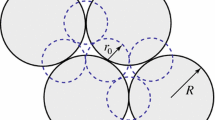Abstract
A generalized dependence of the detonation diameter of closed-porosity explosives on the relative density is obtained in the form of anU-shaped curve. The right branch of the curve can be described within the framework of the theory of V. S. Trofimov. The linear rate of chemical conversion of a substance at an interface is approximately proportional to the pressure. It is shown that despite its purely approximate character, the qualitative theory of Yu. B. Khariton yields the same values of the average reaction rates as the theory of V. S. Trofimov if the coefficient in Khariton’s formula is assumed to be equal to 5. It is noted that in almost all cases the gasification rate of explosives in a detonation wave is greater by a factor of 2–3 than the usual burning rates, which were obtained by extrapolation of the quantities measured in a constant-pressure shell. We propose a mechanism of forced gasification of explosives by a shock-heated gas which fills the pores. The left part of the curve is described under the assumption that the specific combustion surface of low-density explosives is limited by the shock-compression energy supplied to form a heated layer necessary to ignite a detonating substance.
Similar content being viewed by others
References
V. O. Rozing and Yu. B. Khariton, “Cessation of detonation of explosives at small diameters of charges,”Dokl. Akad. Nauk SSSR,26, No. 4, 360 (1940).
K. M. Mikhailyuk and V. S. Trofimov, “Possible gas-dynamic limit of propagation of a stationary detonation,”Fiz. Goreniya Vzryva,13, No. 4, 606–613 (1977).
J. B. Bdzil, “Steady-state two-dimensional detonation,”J. Fluid Mech.,108, 195–226 (1981).
I. F. Kobylkin and V. S. Solovyev,Critical Conditions for Propagation of Detonation Processes: Textbook [in Russian], Bauman Moscow Higher Engineering School, Moscow (1991).
A. N. Dremin, S. D. Savrov, V. S. Trofimov, and K. K. Shvedov,Detonation Waves in Condensed Media [in Russian], Nauka, Moscow (1970).
G. D. Kozak, B. N. Kondrikov, and V. B. Oblomskii, “Spin detonation in solids,”Fiz. Goreniya Vzryva,25, No. 4, 86–93 (1989).
G. D. Kozak, B. N. Kondrikov, and V. B. Oblomskii, “Spin wave and detonation attenuation of liquid explosives,”Fiz. Goreniya Vzryva,28, No. 2, 93–98 (1992).
B. N. Kondrikov and A. I. Sumin, “Equation of state for gases at high pressure,”Fiz. Goreniya Vzryva,23, No. 1, 114–122 (1987).
B. N. Kondrikov, G. D. Kozak, V. B. Oblomskii, and A. V. Savkin, “Detonation transformations in an aerated liquid,”Fiz. Goreniya Vzryva,23, No. 2, 83–91 (1987).
G. D. Kozak, B. N. Kondrikov, S. M. Khoroshev, and V. É. Annikov, “Detonation of aerated systems based on trotyl and dinitrotoluene,” in:Explosive Materials and Pyrotechnics [in Russian], No. 3 (218) (1992), p. 20.
K. K. Andreev, B. N. Kondrikov, and E. A. Rybakov, “The effect of initial temperature and viscosity of nitroglycerine on the sensitivity of its mixture with sodium chloride to detonation,” in:Explosive Science 68/25 [in Russian], Nedra, Moscow (1970), p. 222.
C. J. Andersen, K. von Rosen, A. W. Gileb, and I. O. Moen, “Detonation properties of explosive foams,” in:Proc. 9th Symp. (Int.) on Detonation, Portland, Oregon (1989), pp. 1364–1370.
V. N. Gamezo, G. D. Kozak, B. N. Kondrikov, et al., “Detonation of aerated trotyl and dinitrotoluene,” in:Materials of 5th All-Union Meeting on Detonation [in Russian], Joint Institute of Chemical Physics, Acad. Sci, of the USSR, Chernogolovka (1991), Vol. 2, pp. 326–330.
V. É. Annikov, B. N. Kondrikov, N. N. Korneeva, and S. N. Puzyrev, “Detonation mechanism for gas-filled aqueous gels,”Fiz. Goreniya Vzryva,19, No. 4, 139–143 (1983).
B. N. Kondrikov, “The limits of applicability of usual kinetic relations to the detonation wave chemistry. Homogeneous explosives,”J. de Phys. III,5 (1995), pp. c4-163–c4-170.
G. D. Kozak, B. N. Kondrikov, and M. Yu. Eliseenkov, “The effect of viscosity on the detonation stability of diethyleneglycol dinitrate,”Fiz. Goreniya Vzryva,32, No. 1, 111–114 (1996).
A. N. Afanasenkov, V. M. Bogomolov, and I. M. Voskoboinikov, “Critical conditions of explosion initiation,” in:Explosive Science 68/25 [in Russian], Nedra, Moscow (1970), p. 68.
B. N. Kondrikov, V. M. Raikova, and B. S. Samsonov, “Kinetics of the combustion of nitro compounds at high pressures,”Fiz. Goreniya Vzryva,9, No. 1, 84–89 (1973).
Additional information
Mendeleev Chemical Engineering University, Moscow 125047. Translated from Fizika Goreniya i Vzryva, Vol. 33, No. 2, pp. 111–123, March—April, 1997.
Rights and permissions
About this article
Cite this article
Kondrikov, B.N., Annikov, V.É. & Kozak, G.D. A generalized dependence of the critical detonation diameter of porous substances on the density. Combust Explos Shock Waves 33, 219–229 (1997). https://doi.org/10.1007/BF02671919
Received:
Revised:
Issue Date:
DOI: https://doi.org/10.1007/BF02671919




